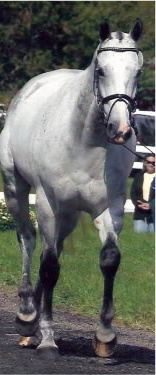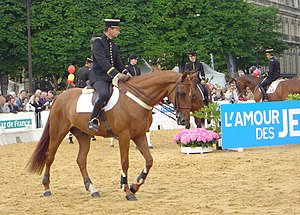 Do you ever stare in awe at the sleek shiny horses, the glistening brass, perfect braids, and dazzling white marks at a CCI trot up? Do you ever wonder how they get that way? (LOTS of hard work is the correct answer!) Each Sunday morning we will bring you a little insider info on how the big-time grooms manage an upper level event horse. Feel free to email or comment with specific grooming questions if you have a topic in mind!
Do you ever stare in awe at the sleek shiny horses, the glistening brass, perfect braids, and dazzling white marks at a CCI trot up? Do you ever wonder how they get that way? (LOTS of hard work is the correct answer!) Each Sunday morning we will bring you a little insider info on how the big-time grooms manage an upper level event horse. Feel free to email or comment with specific grooming questions if you have a topic in mind!
Previous entries: Girths
To see all previous entries, click on the “Sunday Jog-Up” category in the sidebar to the right.
Breastplates & Breastcollars & Breastgirths
A breastplate, breastcollar, or breastgirth (pick a name, any name) is used to prevent your saddle from sliding back. In an ideal, flat world, perfect-fitting saddles would never shift from proper position on a horse’s back. But, add in galloping over varied terrain and monster jumps…well even the best saddle might slide a bit. So, let’s find something to strap it down!
Hunting Breastplate
One of the most common, popular styles of saddle-strap-down items is the “hunting breastplate.” This breastplate attaches to the saddle d-rings (or d-savers) and between the front legs at the girth. It is reasonably effective, but some believe it can restrict the horse’s shoulders. Some models are available with elastic inserts for more shoulder freedom; just beware that the elastic will weaken and stretch over time. The center ring should rest on the horse’s chest muscles, not at the base of the neck (windpipe). Adjust the side straps accordingly. When properly fitted, you should be able to fit a fist between the horse’s chest and the center strap ring; this allows for full extension of the shoulder while galloping. While standing at rest, you may pull a foreleg forward and notice how it takes the slack in the breastplate. The center ring allows the use of a martingale attachment– just be sure the attachment fits properly…many running forks are too short. When using a martingale and a breastplate, the martingale should go OVER the breastplate– that is, put the breastplate on the neck first, then the martingale; this way the martingale is unrestricted. Remember it alphabetically: “B before M!”
Polo Breastcollar

The red breastcollar known everywhere, Bruce Davidson
The polo breastcollar (why it’s a “collar” and not a “plate” I’m not sure; I don’t make the rules, I just follow them) functions a bit differently than the hunting breastplate. Its points of attachment lie at the girth, so it cannot pull the points of the saddle tree into the horse’s withers. A neck strap crossing the crest keeps it from slipping down; it should hang horizontally just above the point of shoulder, yet below the base of the windpipe. The webbing may be made of worsted wool (colors!), leather, or heavy elastic. Elastic allows a bit of “give,” yet may not be 100% reliable to hold your saddle in proper place. As with the hunting breastplate, the polo breastcollar should allow about a fist to fit inbetween the web and chest while the horse stands at rest. Elastic versions may be fitted slightly more snugly, but not tight.
The latest invention in the breastplate market is the “5-point” breastplate which took the event world by storm a few seasons ago. A hybrid of the hunting style and polo breastcollar, it attaches to your saddle via 5-points (hence the name): each side of the girth, the d-rings, and the girth between the legs. This distributes pressure nicely, and lifting the attachment point (the fleecy side ring) allows maximum shoulder freedom. The elastic insert can’t hurt, either! As with the hunting breastplate, however, there is still risk of digging the saddle down into the horse’s shoulder blades. It can make a poorly-fitting saddle even worse, by strapping it down so securely. Also, cleaning the fleecy bits can be a pain in the butt! Like hunting breastplates, the 5-point also allows for martingale attachments. As with hunting styles, be sure the attachments are adjusted correctly.
Jumper Breastgirth
Why can’t these breast-plate/-collar/-girth people just pick a term and stick with it? The jumper-style breastgirth is essentially the webbing of the polo breastcollar, but without the neck strap. It attaches only at the saddle d-rings, resting at the base of the neck. Often made of elastic, or with generous elastic inserts, they allow pretty good freedom of the shoulder. However, it is easy for the webbing to press on the base of the windpipe. I’ve never encountered a problem in fitting a breastgirth, but I always worry about it. This style is more limited in its effectiveness compared to the others– the horse’s neck is the primary object counter-balancing the saddle, as opposed to the horse’s chest used by the hunting, polo, and 5-point breastplates. As with the others, allow 4-5 fingers, or a fist (less if elastic) between the horse and the collar. The best thing about the jumper breastgirth? It’s great for the lazy…no need to slip it over the horse’s head, just attach each side to the d-rings.




















